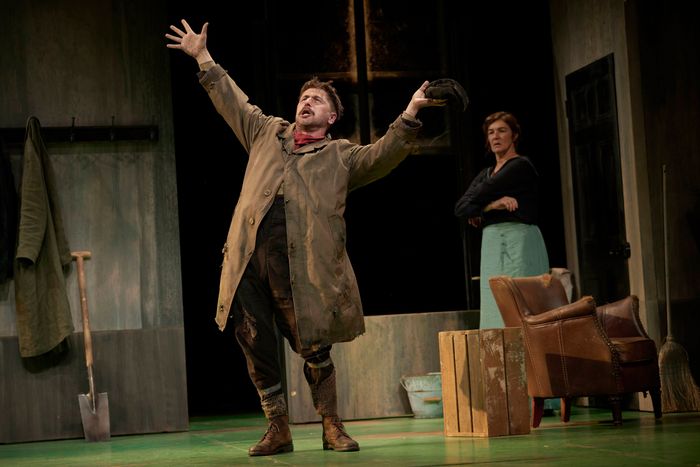
Lay the transparency of the early 21st century across the page of the same years in the 20th and the shape of the one seen through the other is enough to shake a person’s faith that we’ll ever sort ourselves out. It’s a brutal double-image: the warping of revolutionary ideals into violent nationalism, the rise of demagoguery, the clampdown of authoritarianism, the killing, the killing — and, through it all, whoever’s on top, the state-sanctioned abandonment, denigration, manipulation, and disposal of the poorest and least powerful. Perhaps it’s no wonder that the plays of Sean O’Casey — who was writing a century ago in a newly and precariously independent Ireland and made a political journey from committed leftism to rejecting virtually all isms — should resound with such freshness and force as the world spins into the ’20s once again, with undiminished turbulence. The lasting fierceness in O’Casey’s work is, at once, terribly bitter and, artistically, full of a sad, complex sweetness. He feels shockingly modern — incredibly funny, relentlessly tragic, radical, and nuanced in his portraits of the people who, no matter who wins, always do the losing.
In America, O’Casey’s plays are often relegated to History of Theater syllabi or to grad-school scene-study classes meant to help actors add “Irish dialect” to their lists of special skills. The arrival of his entire Dublin Trilogy via director Garry Hynes and the Irish theater company Druid (which Hynes co-founded in 1975) is, therefore, a rare thrill. Watching Druid take on The Plough and the Stars, The Shadow of a Gunman, and Juno and the Paycock feels, at least in theory, a bit like watching the Moscow Art Theatre present Chekhov’s big four. Even if the performances aren’t necessarily authoritative, it’s impossible to come away without a visceral sense of how these plays are fashioned from the same clay as the people bringing them to life. There is shared soil here, shared blood and bone.
Hynes’s ensemble is at home in the epic, semi-archaeological dramatic endeavor. They’ve staged multiple marathons, including DruidShakespeare (a six-hour adaptation of Richard II, both parts of Henry IV, and Henry V) and Martin McDonagh’s Leenane Trilogy, as well as DruidSynge, DruidMurphy, and DruidGregory. Francis O’Connor, the set and costume designer for DruidO’Casey, has said that he and Hynes view this trilogy as “one play in three parts over seven tumultuous years” — and the shows do move with the feeling of one long, arcing bowshot. Beginnings and endings, as well as the tops and tails of acts, are de-emphasized. As a mottled gray-green wall flies in and out, concealing and revealing O’Connor’s reconfigurable tenement set, there’s the feeling that we’re being treated to snapshots, and the hardscrabble lives of O’Casey’s characters flow on, past and through great and small events alike, whether we are witnessing them or not.
As a young man, O’Casey was an Irish Republican militant but eventually focused his storytelling on the people who rarely had a witness, the ones who were just trying to make it through the day without getting shot. The heroic myth of the ones who did the shooting, the feared and romanticized IRA soldiers, forms the basis of the strongest offering in DruidO’Casey — the trilogy’s middle play, The Shadow of a Gunman. The year is 1920, the papers are filled with the daily casualties of the guerilla war for Irish independence, and Donal Davoren (the utterly compelling Marty Rea) has just moved into a shabby tenement room with the peddler — and delightfully motor-mouthed amateur philosopher — Seumas Shields (a robust Rory Nolan). Donal is a poet, though he doesn’t manage to write much between Seumas’s soliloquies and his snoring, along with the constant invasions of their neighbors. This lack of privacy runs through all three plays: Each one takes place in a ramshackle building where the doors are unlocked, the stairs are crowded, and the apartment of one family (or, here, one set of roommates) becomes the public square for all. Gunman, however, is the only play where the domestic space is run by men, and so, of course, it’s a mess.
And so is Donal. Poor dear — all he wants is a little peace and quiet, and maybe to be the next Shelley. But something about this tall, dark (well, tall, lanky, and bespectacled) stranger has the locals convinced he’s more than a poet. There’s a rumor going around that he’s “a gunman on the run” — a rumor Donal might be more inclined to quash if it weren’t for his swooning upstairs neighbor, Minnie Powell (Caitríona Ennis). No one finds the idea of a Fenian assassin in hiding more romantic than Minnie, and Donal is flattered (and horny) enough not to disabuse her. Once the deception is underway — and a Chekhov’s gun of a bag is casually dropped off in the boys’ flat near the top of the play — the stage is set for 75 minutes of breathless farce, which ultimately crash into a final 15 of awful, inevitable devastation.
This is the O’Casey structure: We laugh right up until the hammer falls. (It’s easy to see his theatrical DNA in the brutal hilarity of Martin McDonagh, though O’Casey’s work has more lyricism and more soul.) In Gunman, the formula is at its most condensed and, at least in Druid’s renditions, its most effective. Rea and Nolan are a phenomenal double act, wonderfully sharp as comedians and, when the play takes its turn, suddenly stomach-wrenching as two men reduced to puddles of quivering fear. And as the “very pretty, but very ignorant” Minnie — so Donal sums her up — Ennis nimbly flips a switch from a kind of intentionally overstated comic melodrama to a climactic moment of simple, unhesitating bravery. It’s as if Minnie has learned her affect by studying silent film heroines, which renders her a little ridiculous; but when push comes to terrible shove, she’s ready to play the hero. She’s been training for it her whole life.
What’s astonishing about the savage rush of Gunman’s finale is not simply its violent sorrow but its complexity. O’Casey makes it clear that Minnie’s heroism is intimately linked with what Donal calls her ignorance. She’s an anti-Hamlet — no education, no hesitation, all passionate action. And yet, the play doesn’t dismiss or belittle her. Rather, it holds her in a kind of grave respect, a rageful woe for a world that breeds, disposes of, and then fetishizes courage like hers. In the end, Gunman saves its real judgment for the men who cowered in her shadow.
Along with O’Casey’s clear-eyed depiction of disenfranchisement, the women who populate his plays are a large part of what makes the work feel persistently radical. The men of the Dublin Trilogy are variously pigheaded, profligate, indoctrinated, fearful, feckless, ineffectual, spiteful, misguided, full of charming bullshit, and/or distinctly lacking in spine. There are a few wonderful exceptions — notably The Plough and the Stars’ Fluther Good, a malaproping carpenter who tries to live by his surname, played with glorious, tipsy magnanimity by Aaron Monaghan — though when they are kindly, they tend to be several sheets to the wind, too. (Crucially, and to O’Casey’s great credit, none of the above prevents them from being consistently hilarious, or us from really feeling for them.) Meanwhile, the women work, hold their households together, care for the sick, and mourn the dead, all while keeping their considerable wits about them.
Well, for the most part. The Plough and the Stars — set in 1915 and 1916, before and during the havoc of the Easter Rising — follows the descent of poor Nora Clitheroe (Sophie Lenglinger) into madness. Nora begins the play newly married to Jack (Liam Heslin), a vacillating soldier for the Republican cause. She’s determined to keep her husband safe and respectable — in other words, out of the conflict — and to raise the tone of the tenement house in which she lives. A hard-faced upstairs neighbor, Bessie Burgess (the formidable Hilda Fay), sneers at “[her] ladyship” and grouses over young Mrs. Clitheroe’s social aspirations — but it’s Bessie who, by the play’s end, will wind up caring for poor, broken Nora. It’s unbreakable Bessie — humane and resolute underneath her belligerence — who will shoulder the greatest burden and make the greatest sacrifice.
Plough is a true ensemble play, sweeping in scope and colorful in character. From Bessie’s spitfire frenemy, the charwoman Mrs. Grogan (a feisty Sarah Morris), to the blowsy, good-natured prostitute, Rosie Redmond (Anna Healy), the story conjures an entire community, then rips the tattered rug of their lives out from under them. Marty Rea makes another fiercely entertaining turn as the Young Covey, Jack’s cousin and a zealous socialist. The Covey (the word is a slang reference to his assembly job in a factory) enjoys nothing more than tormenting Nora’s old-fashioned uncle, Peter Flynn (Bosco Hogan), with harangues against the bourgeoisie — but he’s no playwright’s avatar. Every time he demands of some new poor sod, “Did y’ever read, comrade, Jenersky’s Thesis on the Origin, Development, an’ Consolidation of th’ Evolutionary Idea of the Proletariat?” O’Casey is thumbing his nose at all the theoretical socialists out there. It’s very funny stuff, and it still zings. The Covey would have a lot of followers on “X.” Meanwhile, as he yammers on, the flag he supposedly stands under — the flag that originally stood for workers’ rights, peace, and freedom, and that gives the play its name — is being actively appropriated by the deadly forces of nationalism.
Though Plough is the chronological start of the Dublin Trilogy, it’s the last of the three plays O’Casey wrote, and its relative maturity shows. Its ambition is vast, its rhythms muscular and musical, and its punches hit hard. It’s not exactly a tight script, but it lands on the right side of the line between baggy and expansive. The same can’t always be said for Juno and the Paycock. While DruidO’Casey has the throughline of an arrow’s flight, it also, less fortunately, has its arc: The marathon builds gradually into harrowing effectiveness over the course of Plough, peaks unquestionably with Gunman, and then, somewhat disappointingly, falls away. Though Juno features a powerful finale, it spins its wheels a bit on the way there.
By now, it’s 1922: Irish independence is at hand, and families like the Boyles want to keep the ongoing sputters of violence in back alleys and on dark country roads as far out of sight and mind as possible. But there are still no locks on the doors, and death, like the neighbors, doesn’t knock. His touch is already on the one good shoulder of Johnny Boyle (Tommy Harris), the son of the house, a sullen young man with a bullet-mangled hip and a missing arm. “Haven’t I done enough for Ireland?” he demands bitterly. We know the grim answer before hearing it.
In Juno, we follow the Boyles through a perilous rise — thanks to the appearance of a will that seems to leave them rich — and, like Nora and Bessie and Donal and Minnie before them, an inevitable, shattering fall. Though it’s looser and less funny than Plough on its journey towards the cliff, Juno is also more formally daring when it reaches it. There’s a reason we’ve been told that the Boyle daughter, Mary (Zara Devlin), is reading Ibsen. “She’s always readin’ lately — nothin’ but trash, too,” grumbles her father, “Captain” Jack Boyle — a professional idler played with fantastic bombast and swagger, and then with real menace, in a second fine performance by Nolan — to his buddy-in-drunkenness, the ingratiating Joxer Daly (Monaghan, back again and wonderful as a kind of dimmed, degraded reflection of the endearing Fluther Good).
O’Casey puts A Doll’s House and Ghosts in the air, then proceeds to combine strains of the author who created another famous Nora with an existential stripping out of the stage. And with their final images, Hynes and O’Connor do justice to the play’s thrust towards desolation. The space is hollowed out, furniture removed, flats turned upstage with their structural timbers and unsightly stage weights revealed — and in the void stands Juno.
Fay, who brought such bite and backbone to Plough’s Bessie Burgess, returns as the Boyle matriarch in a softer, though equally potent performance. Her eventual awakening, and her radical refusal to be dragged into the pit along with her dissipated husband — he’s the strutting, self-satisfied “paycock” of the title — form the play’s spine. Though Captain Jack insists his wife earned her nickname because she was “born an’ christened in June; I met her in June; we were married in June, an’ Johnny was born in June,” it’s no accident that Juno and the month in question are also named for the long-suffering queen of the gods. The final resounding wallop packed by O’Casey’s play comes from the way in which he leaves mother and daughter standing, while abandoning the wastrel Jupiter and his jester to wallow in their own filth.
At the end of every play in the Dublin Trilogy, the stage has pushed beyond the real into a dense and resonant space of metaphor. O’Casey is too smart, and too funny, to succumb to nihilism, but he’s also too smart, and too full of grief, not to acknowledge the darkness on all sides. The wrecked and ransacked homes, the bodies of their inhabitants — broken, mad, dead, or dead drunk: This is the Ireland O’Casey sees in the wake of another glorious revolution. “The whole worl’s in a state o’ chassis!” squawks Juno’s paycock. Captain Boyle’s personal misnomer for “chaos” is a recurring refrain, and like each of O’Casey’s plays, it plummets from hilarity into hideousness. In taking on the Dublin Trilogy, the Druid ensemble has done more than retrieve a book of long-past plays from a dusty shelf; it has staged an eloquent reminder of how terribly present these plays still sound.
DruidO’Casey is at NYU’s Skirball Center through October 14 (the final marathon day).





